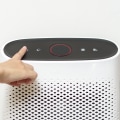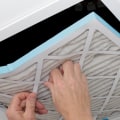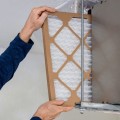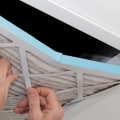Ideally, if you suffer from allergies, you should choose a MERV rating of 17 or higher. This is the most effective at blocking particles that cause allergy symptoms.
MERV ratings
from 9 to 11 mean at least 90% particle resistance, and if you have extreme allergies, you should look for a filter with at least a MERV rating of nine. These filters can capture particles as small as one micron.For most residential homes, a MERV rating of 5 to 8 is appropriate. However, if you have allergies, you'll need a filter with a MERV rating of around 10 to 14 to make sure it filters out particles such as pollen, mold spores, and pet dander. An air conditioning filter with a MERV rating of 11 or higher can effectively remove 75% of allergens circulating throughout the home. Filters rated 17 or higher are even more effective at blocking allergens, but they also block more air, restricting airflow. The higher the MERV rating, the better the filter will collect microscopic particles such as viruses, germs and fine debris.
When choosing the best oven filters for allergies, you'll want to select a filter with a MERV rating between 11 and 13 for best results. According to ASHRAE, air filters with a MERV rating of 10 or higher are best for removing smaller airborne allergens, such as pet dander. This is actually more impressive than even the best MERV rating, which can only remove particles as small as 0.3 microns. It exclusively rates filters based on their ability to remove particles smaller than 1.0 microns and does not account for larger microns. Since you'll get lower airflow with high MERV filters, make sure your oven can maintain sufficient airflow and static pressure with the filter of your choice.
A MERV-10 filter at least 3 inches thick and pleated will capture up to 80% of your home's allergens, greatly reducing your allergic reactions. While filters with higher MERV ratings will eliminate common allergens, those specifically designed for people with allergies may have additional features that specifically address these issues. Below is a graph of the different MERV ratings, the particle sizes they remove, and examples of the corresponding allergens and other particulates. A MERV 1 filter traps dust bunnies, but allows most dust to pass through it, while a MERV 16 traps bacteria and particles as small as 0.3 microns. Some even claim that they remove particles that are smaller than 0.3 microns, which is what removes them from the MERV ratings we've been discussing so far.
Although they last a long time, they only filter approximately 95% of allergens from the air and do not offer the same protection against viruses as other high-MERV disposable types. People suffering from allergies, asthma, respiratory conditions, or other conditions that leave them immunocompromised should look for filters with higher MERV ratings. This particular model is comparable to the Honeywell Allergen Elite and provides a MERV rating of 13. Therefore, for a filter that has a MERV rating of 4 or less, it can only trap particles that are between 3.0 and 10.0 microns. While some families can easily purchase and maintain a filter with a higher MERV rating, others may not. MERV ratings are how air filters are rated based on their ability to clean air and capture particles of different sizes. If you suffer from allergies or other respiratory conditions, it's important to choose an air filter with an appropriate MERV rating in order to ensure that your home's air is free from allergens and other harmful particulates.






